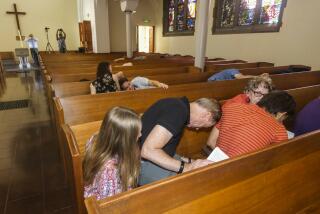Samoans in Carson hold church services for tsunami, earthquake victims
- Share via
Rocking an infant nephew in her arms, Mary Poloai stood outside the main entrance of the imposing Samoan Congregational Christian Church in Carson on Wednesday staring up at the sky and fighting back tears.
“I’m so sad that I can’t think straight,” said Poloai, 58, one of more than 100 people who gathered at a special prayer service for victims of the earthquake and tsunami that devastated Samoa and American Samoa early Tuesday.
“They still haven’t found my mother’s sisters,” she said. “I watched the news till 1 o’clock in the morning and tried and tried to call, but I couldn’t get through on the phone. Then I prayed.”
Pastors and local chiefs scrambled Wednesday to organize relief efforts for victims in their ancestral homelands half a world away, and to deal with growing apprehension and anxiety among relatives and neighbors throughout Los Angeles County, home to an estimated 50,000 Samoans -- the largest population in the U.S.
“News reports from Samoa have gone from bad to very bad,” said Chief Loa Pele Faletogo, president of the Carson-based Samoan Federation of America, a grass-roots organization that provides counseling, immigration referrals and government surplus food to Samoans, Filipinos and others.
“Now, people are coming here crying and searching for answers,” he said. “I have to be brave and comforting, and show that we can come together in these difficult times.”
That wasn’t easy. Like many others, Faletogo has not been able to account for all of his relatives, including some who lived in villages flattened by towering waves. “We’re all really edgy and apprehensive,” he said, “hoping the news doesn’t get even worse.”
It was the first of several special church services planned for the coming days. Another will be held at 6 p.m. today at the nearby United Samoan Congregational Church.
In the meantime, the National Office of Samoan Affairs, an influential private, nonprofit social organization and advocacy group, has created a new website, helpsamoa.com, to serve as a disaster relief resource. The website was also designed to help Samoans connect with loved ones and to provide news updates.
The disaster has unified Samoan communities from San Diego to Ventura, many of which blossomed after World War II when Samoans and neighboring Tongans began immigrating to the United States to take advantage of military jobs. Many settled in what was then unincorporated Carson -- a hodgepodge of junkyards, landfills and refineries -- because land was cheaper than in nearby Long Beach and San Pedro.
In the years since, thousands have followed, lured by the promise of a better life in a region where industrial blight has been replaced by industrial parks and subdivisions.
Many came to the U.S. from rural villages with a family-oriented, clannish culture dominated by a hierarchy of chiefs usually in control of communal property. In the United States, chiefs are less powerful, but still command great respect and preside over funerals, weddings and, on occasion, responses to catastrophic events.
“There are no borders when it comes to Samoan communities,” Faletogo said.
Carson also includes a community of about 20,000 Filipinos, whose homeland was flooded by a recent typhoon. Several Filipino churches were accepting donations of canned food and clothing. A typhoon benefit concert was planned for Sunday at the Doubletree Hotel Carson Civic Plaza.
“These disasters, which devastated communities thousands of miles away, are also striking the hearts of our Samoan and Filipino families in Carson,” Carson Mayor Jim Dear said. “We are together in this struggle.”
--
More to Read
Sign up for Essential California
The most important California stories and recommendations in your inbox every morning.
You may occasionally receive promotional content from the Los Angeles Times.











